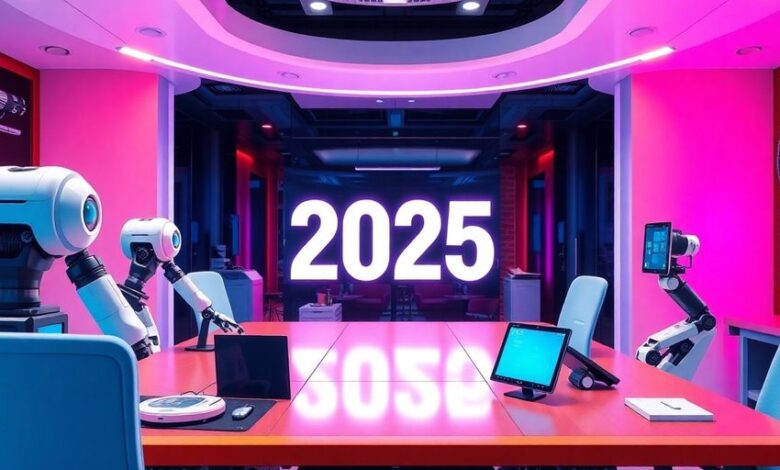
As we look ahead to 2025, the landscape of business is set to change dramatically, thanks to automation and artificial intelligence. Companies are increasingly turning to automated business ideas to streamline operations, enhance customer experiences, and drive growth. This article explores innovative strategies that can help businesses thrive in the coming years, from customer engagement to sustainable practices.
Key Takeaways
- AI chatbots can provide round-the-clock customer support, improving response times.
- Automated inventory management systems can predict stock needs accurately, reducing waste.
- Hyper-localized advertising can target specific audiences effectively, boosting marketing success.
- AI tools can automate financial assessments, enhancing security and investment strategies.
- Healthcare automation can streamline patient management and diagnostics, improving overall care.
Revolutionizing Customer Engagement
Customer engagement is changing fast. It’s not just about selling anymore; it’s about building relationships. People want to feel heard and understood, and automation can actually help with that, believe it or not. It’s all about using the right tools in the right way.
AI-Powered Chatbots for 24/7 Support
Chatbots are getting smarter. They’re not just answering basic questions; they’re understanding context and providing personalized solutions. This means customers can get help anytime, anywhere, without waiting on hold. It’s a huge win for customer satisfaction. I remember when chatbots were terrible, but now they can handle a lot of stuff. It’s pretty cool.
Personalized Marketing Automation
Generic emails are out; personalized experiences are in. Marketing automation tools can now analyze customer data to send targeted messages at the right time. Think about getting an email about a product you were just looking at – that’s the power of personalization. It’s way more effective than just blasting everyone with the same ad. I get so many emails, but the ones that are actually relevant? Those are the ones I open.
Customer Feedback Analysis Tools
Listening to your customers is more important than ever. Feedback analysis tools can automatically collect and analyze customer reviews, surveys, and social media mentions. This gives businesses valuable insights into what they’re doing well and what they need to improve. It’s like having a constant stream of suggestions for making your business better. I always leave reviews, so I hope companies are actually reading them!
Customer engagement is no longer a one-way street. It’s a conversation, and automation can help businesses have more meaningful conversations with their customers. By using AI and data analytics, companies can create personalized experiences that build loyalty and drive sales.
Streamlining Operations with Automation
Let’s be real, running a business is like juggling chainsaws while riding a unicycle. You’ve got a million things to keep track of, and if one thing drops, the whole show goes down. That’s where automation comes in. It’s not about replacing people; it’s about making their jobs easier and more efficient. Think of it as giving everyone a jetpack instead of making them run a marathon. By automating repetitive tasks, you free up your team to focus on the stuff that actually matters – like coming up with new ideas or, you know, not being completely stressed out all the time.
Smart Inventory Management Systems
Remember that time you ran out of widgets and had to overnight them from who-knows-where, costing you a fortune and making a customer furious? Yeah, smart inventory management systems are designed to prevent that kind of disaster. These systems use data to predict demand, track stock levels in real-time, and automatically reorder supplies when needed. It’s like having a crystal ball for your warehouse, except instead of vague prophecies, it gives you accurate inventory forecasts.
Automated Scheduling Solutions
Scheduling is a nightmare. Trying to coordinate everyone’s availability, avoid conflicts, and make sure you have the right people in the right place at the right time? It’s enough to make you want to pull your hair out. Automated scheduling solutions take the pain out of the process. They can automatically assign tasks based on skills, availability, and location, optimizing your workforce and reducing scheduling errors. Plus, they can integrate with other systems, like payroll and time tracking, to streamline your administrative tasks.
Predictive Maintenance Technologies
Imagine if you could predict when your equipment was going to break down before it actually happened. That’s the promise of predictive maintenance technologies. These systems use sensors and data analysis to monitor the condition of your equipment and identify potential problems before they cause downtime. By catching issues early, you can schedule maintenance proactively, minimizing disruptions and extending the lifespan of your assets.
Automation isn’t just about cutting costs; it’s about improving efficiency, reducing errors, and freeing up your team to focus on more important tasks. It’s an investment in the future of your business, and it’s one that’s sure to pay off in the long run.
Innovative Marketing Strategies for 2025
Marketing is changing fast, and by 2025, it’s going to look pretty different. It’s not just about shouting the loudest anymore; it’s about being smart, targeted, and actually useful to people. Think less Mad Men, more AI-powered precision.
Hyper-Localized Advertising Solutions
Forget broad demographics. The future is all about getting super specific with your ads. We’re talking about targeting people based on real-time trends and what’s happening in their specific neighborhood. Imagine ads that change based on the weather or local events. It’s like having a conversation with each person, instead of just talking at them. This approach makes ads way more relevant and effective.
AI-Driven Content Creation Tools
Content is still king, but creating it is getting easier. AI tools can now help with everything from writing blog posts to designing social media graphics. It’s not about replacing creatives, but about giving them superpowers. These tools can analyze data to figure out what kind of content people actually want to see, and then help create it faster. It’s like having a research team and a creative agency all rolled into one.
Data-Driven Customer Persona Development
Knowing your customer is always important, but in 2025, it’s going to be crucial. AI can analyze tons of data to create super detailed customer personas. These aren’t just basic demographics; they include things like their interests, their pain points, and their online behavior. With these personas, you can tailor your marketing messages to really resonate with people. It’s like having a cheat sheet for understanding exactly what makes your customers tick.
The shift towards personalization and ethical consumerism means that marketing strategies need to be more than just persuasive; they need to be authentic and customer-centric. Businesses that prioritize building genuine relationships with their audience will be the ones that thrive.
Enhancing Financial Services Through Automation

Financial services are undergoing a massive transformation, and automation is at the heart of it. By 2025, expect to see even more AI and machine learning integrated into every aspect of finance, from investment strategies to fraud prevention. It’s not just about cutting costs; it’s about making smarter, faster, and more secure decisions. Financial institutions can enhance their competitive edge in 2025 by automating manual processes such as reconciliation and utilizing AI-driven insights to boost operational efficiency.
AI Algorithms for Investment Strategies
AI algorithms are changing how investments are made. These algorithms can analyze huge amounts of data to identify trends and opportunities that humans might miss. It’s not about replacing human fund managers entirely, but about giving them powerful tools to make better decisions. Think of it as augmented intelligence for finance. These algorithms can also be used to personalize investment advice, tailoring recommendations to individual risk profiles and financial goals.
Automated Risk Assessment Tools
Assessing risk is a critical part of financial services, and automation is making it more efficient and accurate. Automated risk assessment tools can analyze a wide range of factors, from credit scores to market conditions, to provide a comprehensive view of risk. This helps financial institutions make better lending decisions and manage their portfolios more effectively.
- Improved accuracy in risk prediction.
- Faster assessment times.
- Reduced human error.
Fraud Detection Systems
Fraud is a constant threat to the financial industry, but AI-powered fraud detection systems are getting better at stopping it. These systems can analyze transactions in real-time to identify suspicious activity and prevent fraudulent transactions from going through. They learn from past fraud attempts to improve their detection capabilities over time. AI chatbots provide round-the-clock client care and financial guidance.
Automation in financial services isn’t just about technology; it’s about building trust. By using AI to detect fraud and manage risk, financial institutions can protect their customers and maintain their reputation.
Transforming Healthcare with AI Solutions
Healthcare is on the cusp of a major transformation, thanks to the rapid advancements in AI. It’s not just about futuristic gadgets anymore; AI is becoming an integral part of how healthcare is delivered, managed, and experienced by both patients and providers. From speeding up diagnoses to personalizing treatment plans, the potential benefits are enormous. Let’s explore some of the key areas where AI is making a real difference.
Automated Patient Management Systems
Imagine a world where scheduling appointments, managing medical records, and handling insurance claims are all streamlined and automated. That’s the promise of AI-powered patient management systems. These systems can significantly reduce the administrative burden on healthcare staff, freeing them up to focus on patient care. For example, AI can automate appointment reminders, reducing no-show rates and improving efficiency. They can also help patients find stay-at-home job opportunities by automating tasks that would otherwise require in-person assistance. Furthermore, AI can analyze patient data to identify those who may be at risk of developing certain conditions, allowing for proactive intervention.
AI-Powered Diagnostic Tools
AI is revolutionizing the way diseases are diagnosed. AI algorithms can analyze medical images, such as X-rays and MRIs, with remarkable accuracy, often surpassing the capabilities of human radiologists. This can lead to earlier and more accurate diagnoses, improving patient outcomes. AI-driven diagnostic tools can also assist in the detection of subtle patterns and anomalies that might be missed by the human eye. This is particularly valuable in areas like cancer screening, where early detection is critical.
Telehealth Automation Platforms
Telehealth is already transforming healthcare, and AI is taking it to the next level. AI-powered telehealth platforms can automate many aspects of virtual care, such as triaging patients, providing personalized health advice, and monitoring chronic conditions. AI chatbots can [handle customer service inquiries] at all hours, answering common questions and providing support. This can improve access to care, particularly for patients in remote areas or those with limited mobility. AI can also analyze data from wearable devices to provide personalized feedback and recommendations, helping patients manage their health proactively.
AI in healthcare isn’t about replacing doctors and nurses; it’s about augmenting their capabilities and empowering them to provide better care. By automating routine tasks and providing valuable insights, AI can help healthcare professionals focus on what they do best: caring for patients.
E-commerce Innovations for a Competitive Edge
The e-commerce world is changing fast, and if you want to stay ahead in 2025, you need to embrace new ideas. It’s not just about having a website anymore; it’s about creating an experience that keeps customers coming back. Innovation is the name of the game.
Automated Customer Journey Mapping
Understanding how customers interact with your brand is more important than ever. Automated customer journey mapping tools can help you visualize the steps a customer takes, from first discovering your product to making a purchase and beyond. This lets you identify pain points and areas for improvement. It’s about making the whole process smoother and more enjoyable for the customer. Think of it as a roadmap to better customer relationships. ecommerce platforms can help with this.
AI-Enhanced Product Recommendations
Generic recommendations are a thing of the past. AI can analyze customer data to provide highly personalized product suggestions. This not only increases sales but also improves customer satisfaction. It’s like having a personal shopper for every customer, guiding them to products they’ll truly love. This is a big deal for boosting revenue and building loyalty.
Dynamic Pricing Strategies
Setting the right price is crucial, and dynamic pricing strategies use algorithms to adjust prices in real-time based on demand, competition, and other factors. This means you can maximize profits without overcharging customers. It’s a delicate balance, but when done right, it can give you a significant edge. It’s all about finding that sweet spot where you’re making money and customers feel like they’re getting a fair deal.
E-commerce is no longer just about selling products online. It’s about creating a complete, integrated experience that meets the evolving needs of today’s consumers. Businesses that embrace automation and AI will be the ones that thrive in the years to come.
Sustainable Business Practices Through Automation

It’s 2025, and going green isn’t just a trend; it’s table stakes for staying competitive. Consumers are way more aware, and they’re putting their money where their mouth is, choosing eco-friendly brands over those that aren’t. Automation offers some pretty cool ways to make your business more sustainable without sacrificing efficiency. It’s about doing well by doing good, and honestly, it’s just smart business.
Energy Management Systems
Okay, so energy management systems might sound boring, but they can seriously cut down on waste and costs. Think smart thermostats that learn your building’s heating and cooling patterns, automatically adjusting to save energy when no one’s around. Or lighting systems that dim or turn off based on occupancy and natural light levels. These systems use data to optimize energy use, reducing your carbon footprint and your utility bills.
Waste Reduction Technologies
Waste is a huge problem, but automation can help tackle it head-on. We’re talking about things like:
- Smart recycling systems that use AI to sort materials more effectively.
- Inventory management software that prevents overstocking and reduces spoilage.
- 3D printing for on-demand manufacturing, minimizing waste from excess production.
These technologies not only reduce waste but can also create new revenue streams by repurposing materials or selling excess inventory.
Sustainable Supply Chain Automation
Your supply chain can be a major source of environmental impact, but automation can make it more sustainable. This includes:
- Using AI to optimize shipping routes, reducing fuel consumption and emissions.
- Implementing blockchain technology for transparent and traceable supply chains, ensuring ethical sourcing and reducing the risk of deforestation or other harmful practices.
- Automated systems for tracking and managing packaging materials, promoting the use of recycled or biodegradable options.
By automating your supply chain, you can gain better visibility into its environmental impact and identify opportunities for improvement. It’s about creating a closed-loop system that minimizes waste and maximizes resource efficiency.
Final Thoughts on Automated Business Ideas for 2025
As we wrap up, it’s clear that the future is bright for those willing to embrace automation in their businesses. The ideas we’ve explored aren’t just concepts; they’re practical steps you can take to stay ahead in a competitive market. Whether it’s using AI to refine your marketing or streamline operations, there’s a lot of potential waiting to be tapped. Remember, the key is to stay adaptable and open to change. The landscape is shifting fast, and those who can pivot will find success. So, gear up for 2025 and get ready to innovate!
Frequently Asked Questions
What are some automated business ideas for 2025?
Some great ideas include AI chatbots for customer support, smart inventory systems, and automated marketing tools.
How can AI help businesses engage with customers?
AI can create personalized marketing, analyze customer feedback, and provide 24/7 support through chatbots.
What are the benefits of automating business operations?
Automation can save time, reduce errors, and improve efficiency in tasks like scheduling and inventory management.
Why is AI important for marketing strategies?
AI helps businesses understand customer behavior, create targeted ads, and develop personalized content.
How does automation improve healthcare services?
Automation in healthcare can streamline patient management, enhance diagnostics, and support telehealth services.
What role does automation play in sustainable business practices?
Automation can optimize energy use, reduce waste, and improve supply chain efficiency, making businesses more eco-friendly.



